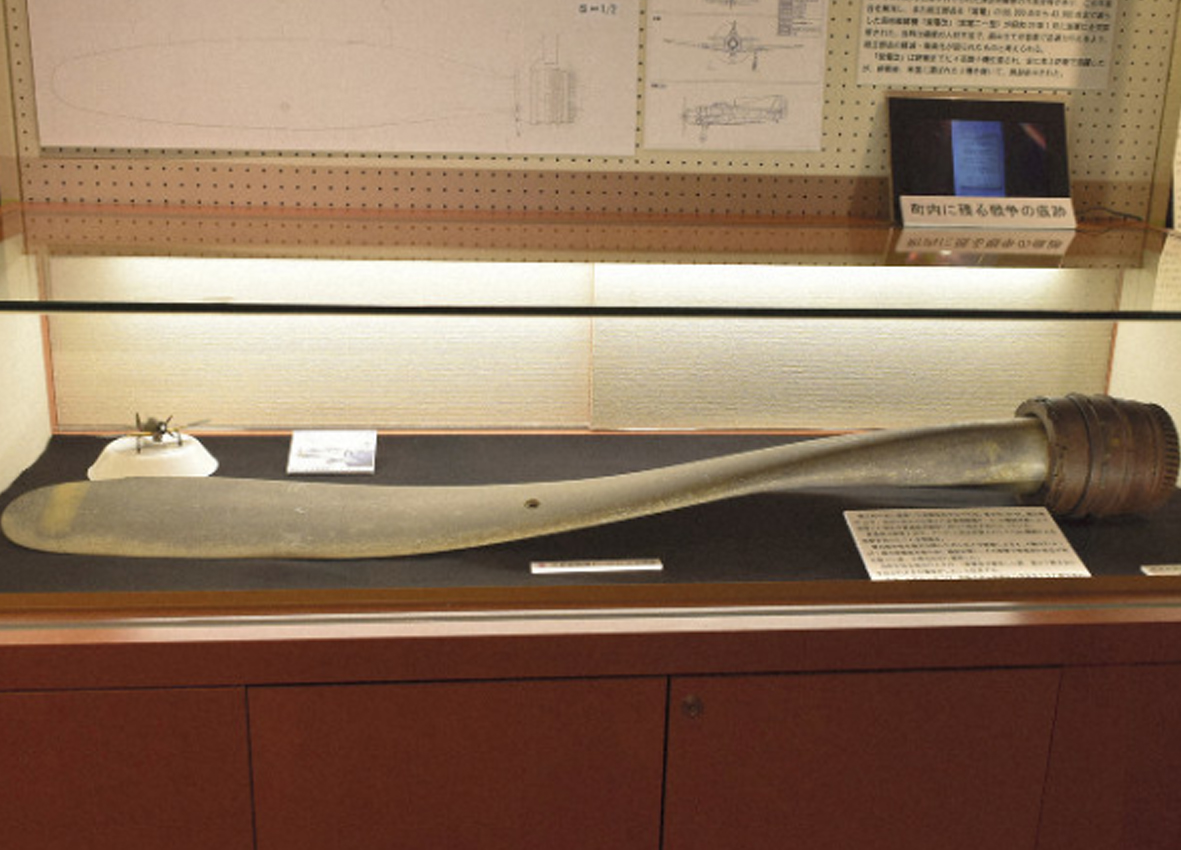 A propeller believed to have belonged to a Shiden-Kai fighter that plunged into a mountainside in Omura, Nagasaki Prefecture, is seen in this photo taken on May 20, 2019. (Mainichi/Naoyuki Yabuta)
A propeller believed to have belonged to a Shiden-Kai fighter that plunged into a mountainside in Omura, Nagasaki Prefecture, is seen in this photo taken on May 20, 2019. (Mainichi/Naoyuki Yabuta)
WWII dogfight footage of 'Shiden-Kai' fighter downing to be shown in Fukuoka Pref.
CHIKUJO, Fukuoka - Dogfight footage of the downing of a Kawanishi Shiden-Kai fighter plane -- one of Imperial Japan's last combat aircraft models -- in the dying days of World War II will be shown at a study center here on May 26.
The 14 seconds of color film taken in 1945 by a U.S. P-51 Mustang fighter gun camera was unearthed in the U.S. National Archives by Toyo no Kuni Usa-shi Juku, a citizens group in southwestern Japan's Usa, Oita Prefecture, that collects and analyzes images of U.S. air attacks in World War II.
The group will make the film available from 2 to 4 p.m. on May 26 at the study center in Funasako Kamaato Park in Chikujo, Fukuoka Prefecture, also in southwestern Japan.
According to historical documents, 24 N1K2-J Shiden-Kai fighters took off from an Imperial Japanese Navy base in Omura, Nagasaki Prefecture, on Aug. 8, 1945, to intercept hundreds of U.S. aircraft attacking parts of Kyushu. Ten of the Japanese planes were shot down in an intense onslaught by American fighters.
One of these was downed by the Mustang at about 10:15 a.m. as the U.S. plane was on its way to attack Tsuiki air field. The Shiden-Kai plunged into a mountainside in Omura's Obara district, and a resident who recalls the crash said, "I heard such a loud blast. I was petrified."
A propeller blade believed to have belonged to the Shiden-Kai and preserved at a local community hall will also be on display at the study center from May 21 to June 16. There is a bullet hole in the 1.6-meter blade, damage apparently inflicted during the dogfight.
About 400 Shiden-Kai interceptors were produced in 1944 and 1945 as part of attempts to regain air superiority over the Japanese home islands as the war situation grew steadily worse.
(Japanese original by Naoyuki Yabuta, Hozen Resident Bureau)
Source: https://mainichi.jp/english/articles/20190521/p2a/00m/0na/021000c
 English
English Japan
Japan

cost of ivermectin buy ivermectin cream for humans ivermectin dosage chart for dogs ivermectin how well does it work
lamictal and neurontin gabapentin online uk is neurontin an anti inflammatory what is the drug gabapentin used for
fast delivery viagra sildenafil dosage levitra vs viagra best generic cialis pharmacy vitamin e dose for men viagra by mail
canadian pharmacy - reputable canadian pharmacy canadian pharmacy online reviews
medicine prednisone deltasone medication para que sirve el prednisone how much does prednisone raise blood sugar in non-diabetic
canadian neighbor pharmacy - Viagra next day viagra 200mg price
lyrica vs neurontin buy gabapentin canada using neurontin for back pain how much gabapentin to take for restless leg
ingredients of viagra alternatives for cialis or viagra viagra for women cialis strength levels taking cialis everyday vintage seed packets for sale levitra medication for adhd children adcirca vs cialis ingredients fda approved medications 2017 sildenafil citrate generic viagra professional 100 mg when to take belviq desitin professional samples good pills sildenafil ingredients in viagra pill is there a women's viagra 10 health benefits of watermelon viagra prescription drugs when will cialis go generic pfizer viagra without a doctor prescription generic viagra manufacturers by country viagra online kaufen viagra overnight shipping how to take sildenafil tablets african mojo by nitroxin cheap viagra prescription walgreens photo coupons 2018 pink ladies hair and makeup natural energy supplements viagra cheap online generic viagra what is the dosage for viagra
ventolin coupon how often can you use albuterol what is ventolin
plaquenil eye pain plaquenil name brand vs generic what pain meds are safe with plaquenil
purchase zithromax online lowest price azithromycin is zithromax sold over the counter how to get a prescription for azithromycin
ivomec ivermectin where to buy ivermectin for guinea pigs how to dose ivermectin for scabies
ivermectin 12mg tablet - stromectol lotion cost ivermectin 3 mg tablets for humans
guinea pig ivermectin ivermectin where to buy ivermectin sheep drench 8 oz how to get the cap off the ivermectin bottle
dapoxetine alza 164 avana dapoxetine vs tramadol for pe cialis and dapoxetine when to take it
cialis trial program cialis 5 mg tablet alcohol viagra side effects viagra generico prescription drugs without prior prescription contrave side effects on women
flovent vs albuterol buy ventolin over the counter how much ventolin is too much what does ventolin-hfa
hab pharmaceuticals modafinil where can i buy modafinil provigil interactions with herbal supplements what ssri goes well with provigil
doubleu casino - play casino online casino games real money
cialis at walmart pharmacy low dose cialis cost cialis and cocaine interaction sildenafil men's health supplements reviews viagra gold usa
amoxicillin on line - amoxicillin on line amoxil
zithromax used for buy azithromycin 1000 mg zithromax walgreens over the counter how to make azithromycin
accutane tablets online - buy accutane usa accutane singapore cost